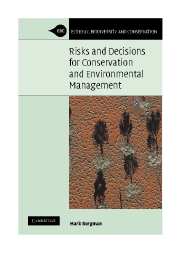Book contents
- Frontmatter
- Contents
- Preface
- Acknowledgments
- 1 Values, history and perception
- 2 Kinds of uncertainty
- 3 Conventions and the risk management cycle
- 4 Experts, stakeholders and elicitation
- 5 Conceptual models and hazard assessment
- 6 Risk ranking
- 7 Ecotoxicology
- 8 Logic trees and decisions
- 9 Interval arithmetic
- 10 Monte Carlo
- 11 Inference, decisions, monitoring and updating
- 12 Decisions and risk management
- Glossary
- References
- Index
6 - Risk ranking
Published online by Cambridge University Press: 03 December 2009
- Frontmatter
- Contents
- Preface
- Acknowledgments
- 1 Values, history and perception
- 2 Kinds of uncertainty
- 3 Conventions and the risk management cycle
- 4 Experts, stakeholders and elicitation
- 5 Conceptual models and hazard assessment
- 6 Risk ranking
- 7 Ecotoxicology
- 8 Logic trees and decisions
- 9 Interval arithmetic
- 10 Monte Carlo
- 11 Inference, decisions, monitoring and updating
- 12 Decisions and risk management
- Glossary
- References
- Index
Summary
Risk ranking represents one of the most common forms of risk analysis. It is used extensively in engineering, mining, land development and industrial contexts in many countries. Yet, as currently practised, it is particularly susceptible to the vagaries of human perception and the inconsistencies of expert judgement outlined in previous chapters. Fortunately, there are some remedies to these problems.
This chapter describes how risk ranking is done. It explores some of the characteristics of the approach. It outlines ways of conducting risk ranking to evaluate more reliably the risk-weighted costs and benefits of environmental management options. These modifications will make risk ranking more useful in the context of the risk management cycle to guide managers to develop strategies that eliminate, reduce or mitigate risks.
Origins of risk ranking methods
Risk ranking is a risk assessment that relies on qualitative, usually subjective, estimates of likelihoods and consequences. It avoids the technical demands of more formal techniques and may use quantitative information where it is available.
In the late 1960s and 1970s, NASA followed examples set by the US military and adopted ‘risk assessment tables’ to assist analysts to quantify and set priorities for risks (Table 6.1). The objective was to create risk assessments that were more reliable than those conducted subjectively and without any guiding principles. Reliability was judged by the repeatability of the resulting relative risk assignments.
- Type
- Chapter
- Information
- Publisher: Cambridge University PressPrint publication year: 2005

